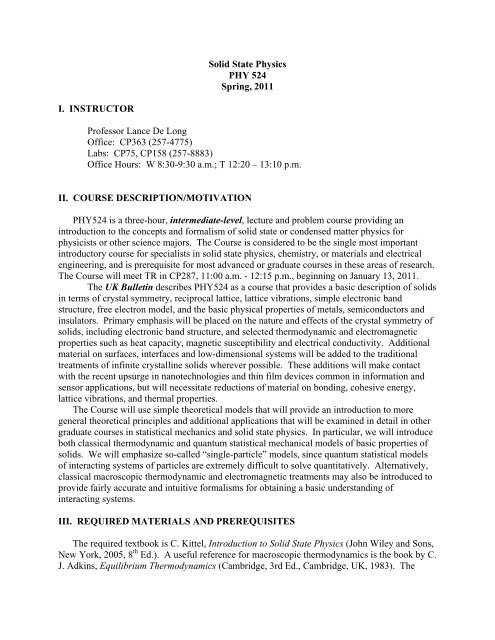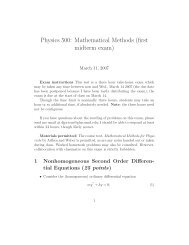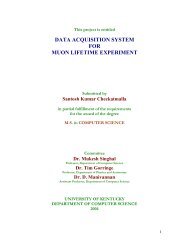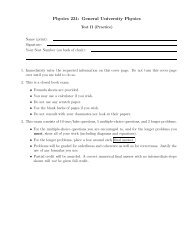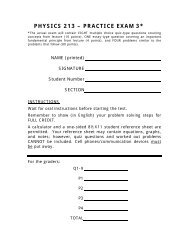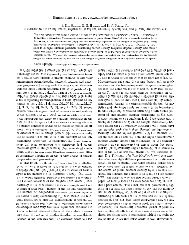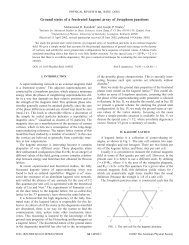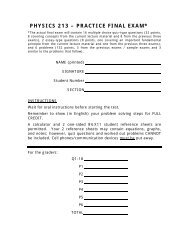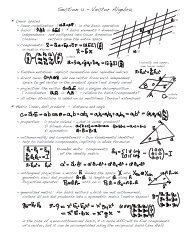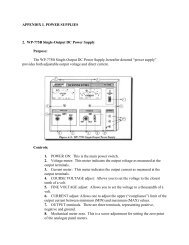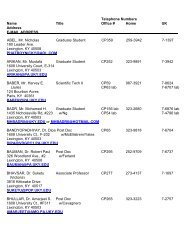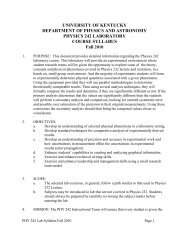Solid State Physics PHY 524 Spring, 2011 I. INSTRUCTOR ...
Solid State Physics PHY 524 Spring, 2011 I. INSTRUCTOR ...
Solid State Physics PHY 524 Spring, 2011 I. INSTRUCTOR ...
Create successful ePaper yourself
Turn your PDF publications into a flip-book with our unique Google optimized e-Paper software.
<strong>Solid</strong> <strong>State</strong> <strong>Physics</strong><br />
<strong>PHY</strong> <strong>524</strong><br />
<strong>Spring</strong>, <strong>2011</strong><br />
I. <strong>INSTRUCTOR</strong><br />
Professor Lance De Long<br />
Office: CP363 (257-4775)<br />
Labs: CP75, CP158 (257-8883)<br />
Office Hours: W 8:30-9:30 a.m.; T 12:20 – 13:10 p.m.<br />
II. COURSE DESCRIPTION/MOTIVATION<br />
<strong>PHY</strong><strong>524</strong> is a three-hour, intermediate-level, lecture and problem course providing an<br />
introduction to the concepts and formalism of solid state or condensed matter physics for<br />
physicists or other science majors. The Course is considered to be the single most important<br />
introductory course for specialists in solid state physics, chemistry, or materials and electrical<br />
engineering, and is prerequisite for most advanced or graduate courses in these areas of research.<br />
The Course will meet TR in CP287, 11:00 a.m. - 12:15 p.m., beginning on January 13, <strong>2011</strong>.<br />
The UK Bulletin describes <strong>PHY</strong><strong>524</strong> as a course that provides a basic description of solids<br />
in terms of crystal symmetry, reciprocal lattice, lattice vibrations, simple electronic band<br />
structure, free electron model, and the basic physical properties of metals, semiconductors and<br />
insulators. Primary emphasis will be placed on the nature and effects of the crystal symmetry of<br />
solids, including electronic band structure, and selected thermodynamic and electromagnetic<br />
properties such as heat capacity, magnetic susceptibility and electrical conductivity. Additional<br />
material on surfaces, interfaces and low-dimensional systems will be added to the traditional<br />
treatments of infinite crystalline solids wherever possible. These additions will make contact<br />
with the recent upsurge in nanotechnologies and thin film devices common in information and<br />
sensor applications, but will necessitate reductions of material on bonding, cohesive energy,<br />
lattice vibrations, and thermal properties.<br />
The Course will use simple theoretical models that will provide an introduction to more<br />
general theoretical principles and additional applications that will be examined in detail in other<br />
graduate courses in statistical mechanics and solid state physics. In particular, we will introduce<br />
both classical thermodynamic and quantum statistical mechanical models of basic properties of<br />
solids. We will emphasize so-called “single-particle” models, since quantum statistical models<br />
of interacting systems of particles are extremely difficult to solve quantitatively. Alternatively,<br />
classical macroscopic thermodynamic and electromagnetic treatments may also be introduced to<br />
provide fairly accurate and intuitive formalisms for obtaining a basic understanding of<br />
interacting systems.<br />
III. REQUIRED MATERIALS AND PREREQUISITES<br />
The required textbook is C. Kittel, Introduction to <strong>Solid</strong> <strong>State</strong> <strong>Physics</strong> (John Wiley and Sons,<br />
New York, 2005, 8 th Ed.). A useful reference for macroscopic thermodynamics is the book by C.<br />
J. Adkins, Equilibrium Thermodynamics (Cambridge, 3rd Ed., Cambridge, UK, 1983). The
<strong>PHY</strong> <strong>524</strong> Syllabus 2 <strong>Spring</strong>, <strong>2011</strong><br />
Instructor will put a few other texts or references on reserve in the Chemistry/<strong>Physics</strong> Library, as<br />
announced. There will also be a copy of the lecture notes, as amended on a semi-regular<br />
schedule, on reserve in the CP Library.<br />
Familiarity with multivariate calculus and partial derivatives will be essential. The course<br />
will assume students are familiar with the elementary principles of electricity and magnetism,<br />
thermodynamics, elementary statistical mechanics, and basic quantum mechanics, at least at the<br />
levels of <strong>PHY</strong> 231, 232 and 361; nevertheless, background at the levels of <strong>PHY</strong> 522, 416, 417<br />
and 520 will be very useful. Students enrolled in EE <strong>524</strong> can expect more difficulty in<br />
understanding and using some of the mathematical models introduced in Upper Division<br />
background courses (especially <strong>PHY</strong>522 and <strong>PHY</strong>520); however, the Instructor will assume that<br />
Engineering students have no prior experience with this material when discussing relevant<br />
models in Lecture.<br />
IV. STUDENT RESPONSIBILITIES<br />
The present Course will emphasize active involvement in class discussion, and the use of<br />
logic and integrative thinking on the part of the student. Therefore, homework exercises will<br />
develop the student's ability to independently apply the information and skills gained in the text,<br />
lecture and previously assigned problems, to new situations. Additional out-of-class preparation<br />
and careful attention in lectures will be necessary for students to learn important skills and<br />
subject matter, and to help them ask productive questions during class time. Students should<br />
also read relevant sections of the textbook or other references (on Reserve in the CP Library, for<br />
example) before they are covered in Lecture. Therefore, students should expect to regularly<br />
attend class and to spend around 10 hours per week on homework and background reading.<br />
Homework problems will be assigned from lecture and the textbook. The student can expect<br />
around four or five problems assigned per week, for around 4-5 points of credit for each problem<br />
assigned. Past experience has shown that poor homework performance is highly correlated<br />
with a low course grade.<br />
V. GRADING<br />
The “500-level” of this Course implies that it be taught at a level that both Upper Division<br />
undergraduates and beginning graduate students can accommodate. Undergraduate students will<br />
be assessed by the usual grade scale ranging from “A” to “E”, as outlined in the criteria for<br />
assigning course grades contained in the University of Kentucky Bulletin 2010-<strong>2011</strong>. Note that<br />
Graduate Students must maintain a minimum grade point average of 3.0, which differs from the<br />
Undergraduate rules; in particular, a “C” grade is considered a “poor” performance for Graduate<br />
Students. Consult the UK Graduate School Bulletin for details. The final course grade will be<br />
based on:<br />
A. Homework (total of scores), 40%<br />
B. One Midterm Hour Exam, 20%<br />
C. Final Exam, 40% (to be held in CP187 on Tuesday, May 3, 10:30 a.m. to 12:30 p.m.)<br />
VI. ATTENDENCE AND MAKE-UPS
<strong>PHY</strong> <strong>524</strong> Syllabus 3 <strong>Spring</strong>, <strong>2011</strong><br />
PLEASE NOTE THAT STUDENTS WHO DO NOT ATTEND EITHER OF THE FIRST<br />
TWO LECTURES OF THE COURSE MAY BE DROPPED FROM THE CLASS ROLE.<br />
If you must miss an examination or cannot turn in a homework set, a make-up can be<br />
arranged. Acceptable excuses include serious illness, official University activity (e.g., away<br />
game, field trip), etc. Foreseeable absences, such as University activities, must be cleared with<br />
your instructor at least one week in advance. Unforeseen absences must be excused by your<br />
Instructor no later than one week after the fact in order for a make-up to be allowed. You may<br />
not double-schedule classes or agree to out-of-class exams in conflict with <strong>PHY</strong> <strong>524</strong> exams --<br />
these are not acceptable excuses. The Instructor has the right to request some form of<br />
documentation justifying student absences, and has authority to judge the acceptability of the<br />
excuse, consistent with University rules.<br />
In extraordinary circumstances in which the student has a valid excuse for missing a large<br />
number of assignments or the Final Exam, an "Incomplete" grade may be given, consistent with<br />
University regulations.<br />
VII. Course Evaluations<br />
Course evaluations are an important (and mandatory!) component of our Department's<br />
instructional program. An on-line course evaluation system was developed to allow each student<br />
ample time to evaluate each component of the course and instructor, thus providing the<br />
Department with meaningful numerical scores and detailed commentary while minimizing the<br />
loss of instructional time in the classroom. The evaluation window for <strong>Spring</strong>, <strong>2011</strong> will open<br />
Monday, April 11 to Wednesday, April 27th. To access the system during this time, simply go<br />
the Department of <strong>Physics</strong> Web page at www.pa.uky.edu and click on the link for Course<br />
Evaluations; then follow the instructions. You will need to use your student ID\# to log into the<br />
system, and this will also allow us to monitor who has filled out evaluations. However, when you<br />
log-in you will be assigned a random number that will keep all your comments and scores<br />
anonymous.
<strong>PHY</strong> <strong>524</strong> Syllabus 4 <strong>Spring</strong>, <strong>2011</strong><br />
VIII. COURSE SCHEDULE (TENTATIVE; 01/10/10 VERSION)<br />
DATE ACTIVITY _____TOPIC READINGS/HW<br />
PART ONE: THE STRUCTURE AND SYMMETRIES OF SOLIDS<br />
R Jan 13 L1 Intro to Condensed Matter W2.5-2.8, 3.1-3.5;<br />
C 1<br />
M Jan 17 --- M. L. KING DAY HOLIDAY<br />
T Jan 18 L2 Basics of Crystal Structure and Symmetry K 1; C 2; AM 4, 7;<br />
M Chapts. 1-7<br />
R Jan 20 L3 Crystal Planes and Miller Indices K 1; C 2.1-2.4;<br />
HW#1 Due<br />
T Jan 25 L4 Elastic Scattering of Waves by Crystals K 2; C 4.1-4.2<br />
R Jan 27 L5 Lattice with Basis; Structure and Form Factors K 2; C 4.1-4.2;<br />
HW#2 Due<br />
T Feb 1 L6 Diffraction Conditions (Bragg, Laue) K 2; AM 6<br />
W Feb 2 --- LAST DAY TO DROP COURSE<br />
R Feb 3 L7 Properties of the Reciprocal Lattice; K 2; AM 5; HW#3<br />
Brillouin Zones<br />
Due<br />
T Feb 8 L8 Structure of Surfaces and Interfaces K 17<br />
PART TWO: STABILITY AND EXCITATIONS OF CRYSTAL LATTICES<br />
R Feb 10 L9 Bonding in <strong>Solid</strong>s; One-D van der Waals Model K 1,3; C5.1, 5.6; AM<br />
19-20; W 2.7; HW#4<br />
Due<br />
T Feb 15 L10 Covalent Bonding; Hydrogen Molecular Ion C 5.1-5.2; K 3; L 9;<br />
S 1; W 2.7; AM 19-20<br />
R Feb 17 L11 General Covalent Bonding; Hard Core Repulsion C 5.3; AM 20; K3; W<br />
2; S 1; HW#5 Due<br />
T Feb 22 L12 Ionic Bonding K 3; C5.4; AM 20; A<br />
1, 8.1; W 2.7
<strong>PHY</strong> <strong>524</strong> Syllabus 5 <strong>Spring</strong>, <strong>2011</strong><br />
DATE ACTIVITY TOPIC READINGS/HW<br />
R Feb 24 L13 Elastic Waves in 1-D, Monatomic Lattice (I); K 4; C 6.1-6.2;<br />
Equation of Motion and Born-von Karman BC’s AM 22; HW#6 Due<br />
T Mar 1 L14 Elastic Waves in 1-D, Monatomic Lattice (II) K 4; C 6.1-6.2;<br />
AM 22<br />
R Mar 3 HE1 FIRST HOUR EXAM K Chapts. 1-3<br />
M Mar 7 --- MIDTERM: GRADES POSTED<br />
T Mar 8 L15 Anharmonicity, Thermal Expansion, Conductivity K4<br />
R Mar 10 L16 Elastic Waves in1-D Lattice with Basis K 4; C 6.3;<br />
HW#7 Due<br />
Mar 14-18 --- SPRING VACATION<br />
T Mar 22 L17 Normal Modes, Dispersion Relations K 4, 5; C 6.4-6.5;<br />
R Mar 24 L18 Quantized Lattice Vibrations (Phonons) K 5, App. C<br />
HW#8 Due<br />
T Mar 29 L19 Density of Phonon <strong>State</strong>s in 1-D, 2-D and K 5;<br />
3-D Cases<br />
R Mar 31 L20 Debye and Einstein Models of 3-D Lattice K 5; AM 23;<br />
HW#9 Due<br />
F Apr 1 --- LAST DAY TO WITHDRAW FROM COURSE<br />
PART THREE: ELECTRONIC STRUCTURE OF SOLIDS<br />
T Apr 5 L21 Electrons in Periodic Potentials: Classification K 7; AM 8<br />
Of Orbitals, Bloch’s Theorem, BvK B.C.’s<br />
R Apr 7 L22 Bloch’s Theorem and Formal Symmetries K 7; C 7.2; AM 8;<br />
HW#10 Due<br />
T Apr 12 L23 Kronig-Penny Model I K 7<br />
R Apr 14 L24 Kronig-Penny Model II K7; HW#11 Due<br />
T Apr 19 L25 Nearly Free Electron (NFE) Model I K 7, AM 9; C 7.4
<strong>PHY</strong> <strong>524</strong> Syllabus 6 <strong>Spring</strong>, <strong>2011</strong><br />
DATE ACTIVITY TOPIC READINGS/HW<br />
R Apr 21 L26 Nearly Free Electron (NFE) Model II K 7, AM 9; C 7.4<br />
HW#12 Due<br />
T Apr 26 L27 Examples of Nearly Free Electron Model K 7, AM 9; C 7.4<br />
R Apr 28 L28 Fermi Surface; Classification of <strong>Solid</strong>s K 7, 9; AM<br />
T May 3 FE FINAL EXAMINATION, CP287, 10:30 a.m. to 12:30 p.m.<br />
Coverage includes the contents of HE1.<br />
M May 9 --- GRADES DUE TO REGISTRAR<br />
KEY TO PRIMARY COURSE REFERENCES:<br />
A: C. J. Adkins, “Equilibrium Thermodynamics”, 3 rd Edition (Cambridge U. Press, Cambridge,<br />
1983)<br />
AM:<br />
N. W. Ashcroft and N. D. Mermin, “<strong>Solid</strong> <strong>State</strong> <strong>Physics</strong>”, 1 st Edition (Saunders College,<br />
Philadelphia, 1976)<br />
B: J. S. Blakemore, “<strong>Solid</strong> <strong>State</strong> <strong>Physics</strong>” (Cambridge University Press, 2 nd Ed., Cambridge, 1985)<br />
C: J. R. Christman, “Fundamentals of <strong>Solid</strong> <strong>State</strong> <strong>Physics</strong>” (John Wiley and Sons, New York, 1988)<br />
E: R. M. Eisberg, “Fundamentals of Modern <strong>Physics</strong>” (John Wiley and Sons, New York, 1961)<br />
K: C. Kittel, “Introduction to <strong>Solid</strong> <strong>State</strong> <strong>Physics</strong>”, 8 th Edition (John Wiley and Sons, New York,<br />
2005)<br />
L: R. B. Leighton, “Principles of Modern <strong>Physics</strong>” (McGraw-Hill, New York, 1959)<br />
LL:<br />
L. D. Landau and E. M. Lifshitz, “Electrodynamics of Continuous Media” (Addison-Wesley,<br />
Reading, MA, 1960)<br />
M: H. D. Megaw, “Crystal Structures: A Working Approach”, 1 st Edition (W. B. Saunders,<br />
Philadelphia, 1973)<br />
MK: J. P. Mc Kelvey, “<strong>Solid</strong> <strong>State</strong> and Semiconductor <strong>Physics</strong>” (Krieger, 1982)<br />
RM: J. R. Reitz and F. J. Milford, “Foundations of Electromagnetic Theory” (Addison-Wesley<br />
` Publishing, Reading, MA, 1967).<br />
S: J. C. Slater, “Quantum Theory of Molecules and <strong>Solid</strong>s”, 1 st Edition (McGraw-Hill, New York,<br />
1965)
<strong>PHY</strong> <strong>524</strong> Syllabus 7 <strong>Spring</strong>, <strong>2011</strong><br />
VV:<br />
J. H. Van Vleck, “Electric and Magnetic Susceptibilities” (Oxford University Press, London,<br />
1966)<br />
W: A. J. Walton, “Three Phases of Matter”, 2 nd Edition (Clarendon Press, Oxford, 1983)
<strong>PHY</strong> <strong>524</strong> Syllabus 8 <strong>Spring</strong>, <strong>2011</strong><br />
<strong>PHY</strong><strong>524</strong> COURSE OUTLINE S’04<br />
I. PART ONE: THE STRUCTURE OF SOLIDS<br />
A. Crystallography<br />
1. Crystal Symmetry<br />
a. Lattice Translations<br />
b. Basis<br />
c. Primitive Cell<br />
2. Fundamental Bravais Lattice Types<br />
3. Lattice Planes<br />
B. Crystal Structure Determination<br />
1. Bragg Law<br />
2. Reciprocal Lattice<br />
3. Diffraction Conditions<br />
4. Brillouin Zone<br />
5. Structure and Atomic Form Factors<br />
QUASICRYSTALS<br />
C. Crystal Binding<br />
1. Van der Waals<br />
2. Ionic<br />
3. Covalent<br />
4. Metallic<br />
5. Hydrogen<br />
6. Atomic Radii<br />
7. Elasticity<br />
D. Crystal Vibrational Modes<br />
1. Monatomic Lattice<br />
2. Diatomic Lattice<br />
3. Quantization of Elastic Waves (Phonons)<br />
4. Crystal Momentum<br />
5. Inelastic Scattering Methods<br />
6. Debye-Waller Effect<br />
II. THERMODYNAMICS OF THE CRYSTAL LATTICE<br />
A. Quantization of Lattice Vibrations<br />
1. Normal Modes of Vibration<br />
2. Density of <strong>State</strong>s<br />
3. Bose-Einstein Distribution<br />
4. Debye Model<br />
5. Einstein Model<br />
6. General Methods<br />
B. Anharmonic Effects and Transport Effects<br />
1. Anharmonicity and Thermal Expansion<br />
2. Scattering of Phonons<br />
3. Thermal Conductivity
<strong>PHY</strong> <strong>524</strong> Syllabus 9 <strong>Spring</strong>, <strong>2011</strong><br />
4. Soft Phonons and Phase Transitions<br />
III. ELECTRONIC STRUCTURE OF SOLIDS<br />
A. Free-Electron Model of Metals<br />
1. Wavefunctions for 1-3 Dimensions<br />
2. Density of <strong>State</strong>s<br />
3. Fermi-Dirac Distribution<br />
4. Heat Capacity<br />
B. Debye-Sommerfeld Model<br />
1. Electrical Conductivity<br />
2. Thermal Conductivity<br />
THERMOELECTRICITY<br />
MAGNETOTRANSPORT<br />
NANOSTRUCTURES<br />
SUPERLATTICES<br />
C. Electronic Band Structure and Nearly Free Electron Models<br />
1. Bloch <strong>State</strong>s<br />
2. Kronig-Penny Model<br />
3. Empty Lattice and Zone Boundary Effects<br />
D. Semiclassical Electron Dynamics<br />
1. Band Gap, Electrons and Holes<br />
2. Equation of Motion for Finite Electric and Magnetic Fields<br />
3. Effective Mass Approximation<br />
4. Intrinsic Carriers in Semiconductors<br />
5. Extrinsic Carriers in Semiconductors<br />
6. Zener Breakdown, Diodes<br />
E. Fermi Surface of Metals<br />
1. Wannier <strong>State</strong>s<br />
2. Fermi Surface<br />
3. Wigner-Seitz Cells, Brillouin Zones<br />
4. Zone Schemes (Reduced, Periodic<br />
F. Band Structure Calculations<br />
1. Tight Binding<br />
2. Wigner-Seitz<br />
3. Pseudopotentials<br />
G. Determination of Fermi Surfaces<br />
1. Landau Levels (Quantum Limit)<br />
2. de Haas-van Alphen, Shubnikov-de Haas Effects<br />
3. Electron Orbits<br />
4. Magnetic Breakdown<br />
PART FOUR: DEFECTS AND SURFACE EFFECTS IN SOLIDS<br />
A. Lattice Vacancies
<strong>PHY</strong> <strong>524</strong> Syllabus 10 <strong>Spring</strong>, <strong>2011</strong>


